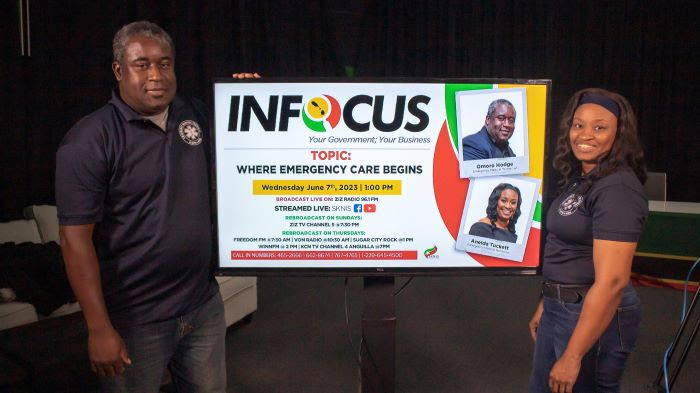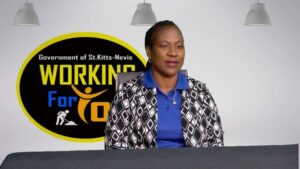Published 8 June 2023
Basseterre
Buckie Got It, St Kitts Nevis News Source
PUBLIC GAINS GREATER INSIGHT INTO EMT OPERATIONS THROUGH INFOCUS
Basseterre, St. Kitts, June 08, 2023 (SKNIS): The June 07 edition of the radio and television programme InFocus gave citizens and residents of St. Kitts and Nevis a better understanding of the operations of the Emergency Medical Services (EMS) and how the men and women who work in the EMS are busy saving lives every day.
On the programme, Emergency Medical Technicians (EMTs) Omoro Hodge and Anelda Tuckett tackled commonly asked questions, such as why emergency callers are asked so many initial questions, difficulties in evacuating persons from some scenes, and why an ambulance may not leave for the hospital immediately after loading patients.
As it relates to interacting with emergency callers, Ms. Tuckett explained that calls for medical emergencies are transferred from 911 to a certified EMT. The EMT will first get to the location of the emergency and dispatch a team to respond while continuing to engage the caller. Questions often include the patient’s age, medical history, and landmarks that may help EMTs quickly identify the patient’s location within the general area, if the patient is breathing, and what the patient is doing at this current time.
“All of these things are what we need to know so that the [emergency] crew can prepare themselves for what they are getting into, so beforehand they can be in the proper mental state of mind for what they are about to meet and deal with,” Ms. Tuckett stated.
EMTs are based at the J. N. France General Hospital in Basseterre, Mary Charles Hospital in Molineux, and the Pogson Medical Center in Sandy Point. EMT Omoro Hodge said that navigating traffic and narrow streets plays an important role in the timeliness of the response of emergency crews. The location and design of various buildings also must be considered.
“We (individuals) don’t build thinking that we are going to get sick, so we have narrow [home] entrances, narrow stairwell cases, and we build going up hillsides, so it makes it difficult for an ambulance to come with a stretcher to remove you from your residence,” said Mr. Hodge. “It makes it difficult trying to get you out in a time-constraint scenario to get you the medical treatment that’s necessary.”
In relation to the time of departure after arriving at the scene of an emergency, Mr. Hodge encouraged the public to dismiss the “pick up and go” notion that most persons seem to hold.
Ms. Tuckett told the listeners and viewers of InFocus that “sometimes we do have to administer initial care before we leave with that person, especially if it’s an asthmatic person who may need oxygen, we do nebulizations in the ambulance, so we can start that process before we actually do get to the hospital.”
Mr. Hodge added that it may also be necessary to set up an IV (intravenous fluids) before leaving a scene.
“We are pre-hospital care, and once the patient gets to the hospital, they (doctors and nurses) would have had an initial set of information from us in the field, and then the doctors would then continue once we get to the hospital,” EMT Hodge indicated.
InFocus airs live on ZIZ Radio and Television every Wednesday at 1 p.m. It is also streamed live on ZIZ’s and SKNIS’ YouTube Channels and Facebook Pages. The show is rebroadcast on various local and regional stations and outlets at different times and days.





